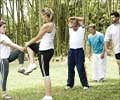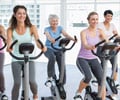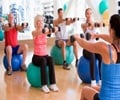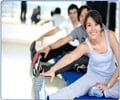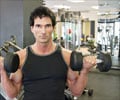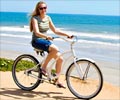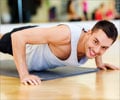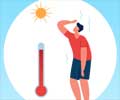How to Plan a Workout Schedule
Your present fitness level, age, health, skills, interest and convenience are among the major factors that you should consider before choosing a specific exercise regimen. The exercise regimen should begin with a warm-up and end with a cool down. If you are actually planning a serious strengthening or stretching exercise schedule to improve your strength, endurance and
- Warm-up: 10 minutes of walking, slow jogging, knee lifts, arm circles or trunk rotations.
- Muscular strength: 20-minute session per week of exercises using weights or resistance
- Muscular endurance: 30-minute once-a-week session of exercises such as push-ups, sit-ups, pull-ups, and weight training for all major muscle groups.
- Cardio respiratory endurance: 20 minutes of continuous aerobic rhythmic exercise once a week, such as brisk walking, jogging, swimming, cycling, rope-jumping, rowing, cross-country skiing, and some continuous action games like racquetball and handball.
- Flexibility: 10-12 minutes of daily stretching exercises performed slowly, without a bouncing motion.
- Cool Down: 5-10 minutes of slow walking, low-level exercise, combined with stretching.
- Too Much Too soon can be harmful!
Too much exercise can be harmful. If you exercise without proper rest, the process can actually increase the chances of circulatory problems, sprain and strain. An improper exercise schedule does more harm than good. Over-exercising the muscles leads to muscle damage. Similarly, sudden cessation of exercise, when you have been at it regularly, creates severe lethargy and a depressed state of mood. This has most commonly been seen in people who stop following a strenuous gym routine. Proper rest and recovery are equally important to health, as is exercise. If the muscles are not rested, the body continues to exist in a permanently injured state. It is necessary to refill the energy stores in the skeletal muscles and liver. Delayed onset of muscle soreness can occur after any kind of exercise, particularly if the body is in an unconditioned state relative to it. Do not try to do too much too soon, and do not quit before you experience improved fitness.
A popular time for exercising is an hour just before the evening meal. A late afternoon workout gives one a relaxing change at the end of the workday and helps dissolve worries and tensions. Another popular time when one can exercise is early morning, before the workday begins. It makes one alert and energetic on the job. It’s important to schedule workouts for a time when there is little chance of canceling or interrupting the activity. One should not exercise strenuously during extremely hot, humid weather or within two hours after eating food. Exercise improves our life in every way, from boosting our mood to improving our sex life. Its benefits are immediately visible, even if one is out-of-shape or hasn’t been active in a long time.
Start out with basic and simple exercises, and add new ones gradually. Start with an activity that you enjoy. Team up with friends or join exercise/dancing classes. Even 10 minutes of activity is better than none! Try walking for 10 minutes a day, a few days a week. Find a time that works for you. Try fitting in 10 minutes of activity before work or in the evening after dinner. Physical activity is an important part of your weight management program. Maximum weight loss occurs because of decreased calorie intake. Sustained physical activity is most helpful in the prevention of weight gain and maintenance of lost weight. In addition, exercise has the benefit of reducing risk of cardiovascular disease and diabetes.
You can exercise either once a day or intermittently throughout the day. Start with a brisk walk for 10-20 minutes and gradually build up to more intense walking. Practice this at least for 5 days a week. Increase everyday activity by taking the stairs instead of the elevator. Reduce sedentary time by increasing physical activity – perform all home activities by yourself instead of asking a maid to do it for you. Competitive sports, such as tennis and volleyball can provide an enjoyable form of exercise.
Knowing when and how much to eat and drink before you exercise can make a big difference to how you feel during and after your workout.

